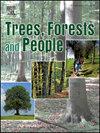Palynological approaches to forest restoration in Southeast Asia: Challenges and opportunities for Thailand—A systematic review
IF 2.7
Q1 FORESTRY
引用次数: 0
Abstract
Southeast Asia (SEA) has experienced significant deforestation and increasing encroachment on its forests over time. This ongoing environmental issue arises from the persistent exploitation of protected forest areas by local communities, leading to further deforestation and the degradation of remnant forests. Although several organizations have implemented restoration measures, these efforts have primarily focused on reforestation. However, replacing once-diverse forests with only a single type of vegetation or non-native species undermines the fundamental objectives of restoration and exacerbates the vulnerability of these ecosystems, particularly affecting biodiversity and ecosystem functions, making them more susceptible to collapse. This paper reviews the application of paleoecology to conservation and restoration efforts in forests worldwide, with a specific focus on SEA, through a systematic review. Out of 833 documents related to palynology and forest restoration worldwide, 19 studies were selected for review based on their clear topical focus on SEA. Of these, 18 studies concentrate on Holocene sediments, while one examines the Pleistocene to Holocene transition. Most studies were conducted in Indonesia, primarily focusing on wetland restoration, particularly in peat swamps. The use of palynological methods in these conditions proves valuable for restoration strategies. Additionally, the review examined challenges and opportunities associated with the palynological approach to forest restoration in Thailand. The findings indicate that there is currently no up-to-date, in-depth palynological analysis in Thailand that incorporates forest restoration efforts. Nevertheless, the palynological approach offers valuable opportunities for forest restoration in Thailand and similar regions.
东南亚森林恢复的古生物学方法:泰国面临的挑战和机遇--系统回顾
随着时间的推移,东南亚(SEA)经历了严重的森林砍伐和日益严重的森林侵占。这一持续的环境问题源于当地社区对森林保护区的持续开发,导致森林进一步砍伐和残余森林的退化。虽然一些组织已经采取了恢复措施,但这些努力主要集中在重新造林上。然而,仅以单一类型的植被或非本地物种取代曾经多样化的森林,有损于恢复的根本目标,并加剧了这些生态系统的脆弱性,特别是影响生物多样性和生态系统功能,使其更容易崩溃。本文通过系统性综述,回顾了古生态学在全球森林保护和恢复工作中的应用,重点关注东南欧。在全球与古生态学和森林恢复相关的 833 篇文献中,我们选择了 19 项研究进行综述,因为这些研究的主题明确聚焦于 SEA。其中,18 项研究集中于全新世沉积物,一项研究探讨了更新世向全新世的过渡。大多数研究都是在印度尼西亚进行的,主要侧重于湿地恢复,特别是泥炭沼泽。事实证明,在这些条件下使用古乐学方法对恢复战略很有价值。此外,研究还探讨了在泰国采用古乐学方法进行森林恢复所面临的挑战和机遇。研究结果表明,泰国目前还没有结合森林恢复工作的最新、深入的古乐谱学分析。然而,古乐谱学方法为泰国及类似地区的森林恢复提供了宝贵的机会。
本文章由计算机程序翻译,如有差异,请以英文原文为准。
求助全文
约1分钟内获得全文
求助全文
来源期刊

Trees, Forests and People
Economics, Econometrics and Finance-Economics, Econometrics and Finance (miscellaneous)
CiteScore
4.30
自引率
7.40%
发文量
172
审稿时长
56 days
 求助内容:
求助内容: 应助结果提醒方式:
应助结果提醒方式:


